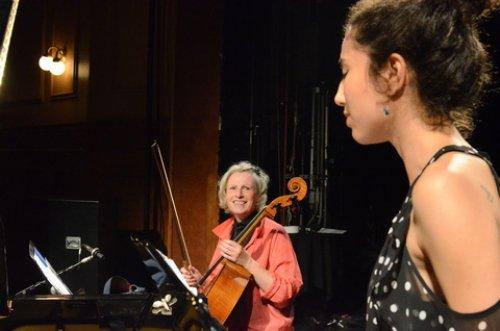New York City Electroacoustic Music Festival 2018: Inspirations and Purposes
Shaped by global influences and richly divergent ideas, electroacoustic music represents the most innovative of contemporary music.

Percussionist Patti Cudd (Photo credit: New York City Electroacoustic Music Festival)
[avatar user=”Jean Ballard Terepka” size=”96″ align=”left” ] Jean Ballard Terepka, Music Critic[/avatar]In this busy New York City Electroacoustic Music Festival of close to 250 electroacoustic works, several core patterns of artistic inspiration emerge from a wide variety of sources.
Computer technology and electronics on the one hand and musical talent on the other merge. Creativity in electroacoustic music is never just ‘science’ or ‘art:’ it is both, and, as a result, composers of this music have a wide variety of cultural and intellectual influences in addition to their own personal histories and identities.
Music itself inspires music. Sometimes composers are influenced by particular composers. Alexander Sigman in the fourth piece to be performed in the first concert (1.4) combines John Dowland with Japanese influences in a jittery comparison of ‘old’ and ‘new’ music. Scott Miller turns Liszt’s Paganini Variations (6.9) into an identity-fracture and Justin Yang finds himself indebted to John Cage (8.3). This year brought two intensely felt memorial pieces by Mary Simoni (8.4) and Victoria Gibson (21.10) in honor of Pauline Oliveros (1932-2016).
Sometimes composers find muses in particular instruments or instrumentalists. Carter Rice in his powerful Flat Circle (20.6) writes for the saxophone. Christine Eloy writes dynamic, tense music for the erhu (2.5). Other composers write for particular artists. Jeffrey Stadelman wrote a piece for virtuosic oboist Megan Kyle (3.10) and David Z. Durant wrote his wild, gorgeous Shadow of the Hawk for percussionist Patti Cudd (9.9).
Literature and the visual arts inspire composers; influences transcend eras and nationalities. Konstantos Karathanasis looked to Pablo Neruda (2.7), Kyle P. Rotolo, to Dante Gabriel Rossetti (3.9) and Bin Li, to Constantine Cavafy (18.1). Jorge Luis Borges inspired Christopher Luna-Mega (18.9); Paul Eluard, Gerald Eckert (21.4) and Robert Fuller Murray, Daniel Fawcett (8.10). In these intersections of music and the written word, composers sometimes set texts to music, or are inspired by an extended story, the quintessence of a poetically described emotion or, in the case of a writer like Borges, a celebration of shapes and patterns.
Geography evokes stories and myths, particular historical events and personal memories. In this Festival, composers, performers and listeners traveled from China to Greece, Mongolia to the Netherlands, and Miami Beach to the hill towns of Tuscany. Sometimes listeners are transported to the other side of the earth; sometimes foreign sounds make us hear our own national tunes and traditions.

Cellist Madeline Shapiro (Photo credit: New York City Electroacoustic Music Festival)
This heady mix of intellectual, cultural and artistic, geographical, historical and personal influences makes for a body of music that reflects our global interconnectedness and the cross pollination of complex and divergent ideas. Western and Asian traditions challenge and enrich each other; universal truths are revealed in new ways.
Interconnected with this rich, densely textured collection of references, assumptions, contrasts and pairings is another major impulse within this community of music-makers. Many of these composers revel in the abstract thrill of technological invention. The scientific thrill of electronic music-writing is revealed in what the composers write about their work.
Concerning his otherworldly, fluid and mysterious Organica (5.4), Antonio D’Amato writes, “This piece comes from the purpose of generating an illusion of a new instrument through analysis, de-structuation, and a recombination of real samples of an acoustic instrument, using mostly progressive subtraction or selective saturation processes … An intensive use of computer-based DSP elaboration is employed … Some dsp algorithms are driven to their extreme settings …” Sever Tipei described the dark, difficult music of his Big Gizmo (6.4) fixed media piece as “a computer assisted composition using additive synthesis sounds… Multiple runs produce multiple variants of the same structure, a family or a class of compositions whose members are equally valid.”
The Festival’s sole lecture-presentation proved useful in revealing how one composer viewed the intersections of science and art in his own composing: trumpeter Skye van Duuren, now a trumpeter and PhD candidate in Composition in the College-Conservatory at the University of Cincinnati spoke on “Bridging Worlds: Creating Fixed Media Microtonal Music with Acoustic Instruments” and then presented the third movement of his Manifestations. Emphasizing the development of his “microtonal language … with traditional chromatic scale as a baseline … and gradations of 5 cents in octaves that each have 240 ‘notes,’ van Duuren discussed the use of Melodyne software to increase the microtones of acoustic instruments.
The sheer variety of influences, inspirations and purposes in the music of this Festival was remarkable. This music represents determination and optimism: fixed media, fixed media and live performing, and videos are in the absolute “right now” of contemporary music. The New York City Electroacoustic Music Festival, even for those familiar with it, is a revelation … and an important affirmation that technology and innovation enhance the music-making that is part of our relationship with the world we inhabit.
New York City Electroacoustic Music Festival 2018 (21 concerts; July 16 – July 22, 2018)
Abrons Arts Center, 466 Grand Street, between Pitt and Willett Streets, in Manhattan
For more information: http://www.nycemf.org
Running time: Approximately 90 minutes with one intermission for each concert






Flirting annd relationships have always
gone tkgether similar tto the moon and stars.
Think of computer in this way, perhaps yyou have had a buddy which was just kind of
a weenie. Use one per day because exhausting them for
a passing ffancy occasion will add wigh nothing for tomorrow.